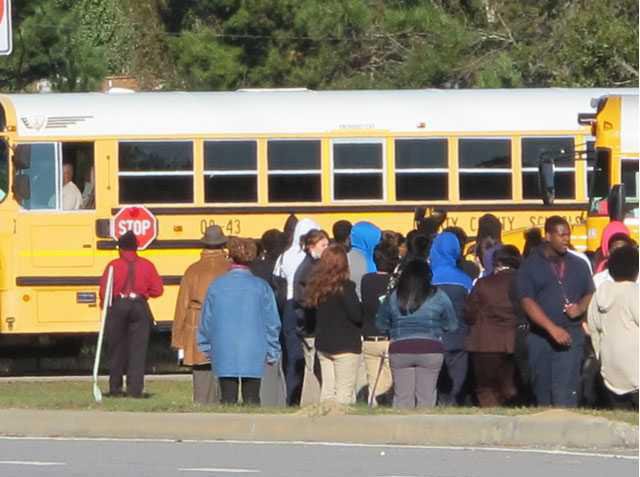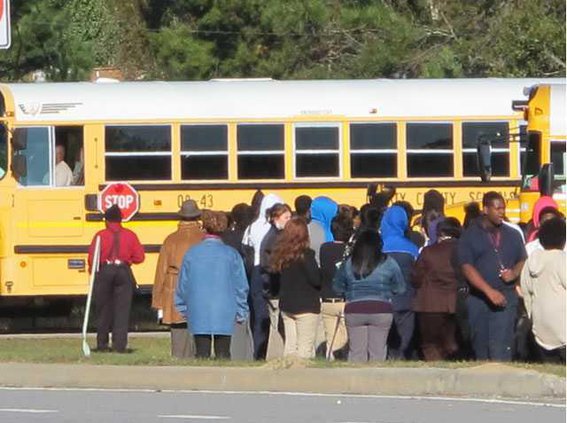School administrators are well aware that a crisis can happen anywhere — even here — putting staff and students at risk, which is why the district prioritizes safety.
Just before 3 a.m. Saturday, Oct. 5, there was a standoff between police and an armed man in Flemington. The standoff occurred in a neighborhood near Joseph Martin Elementary and Snelson-Golden Middle schools. The standoff ended with the suspect being shot and wounded. The man, Ryan Alexander Messer, allegedly brandished two handguns before climbing onto the roof of his home on Woody Court, yelling at police officers who were trying to get him down safely.
Fortunately, this crisis happened on a day when school was not in session.
On the morning of Nov. 13, Midway Middle School’s evacuation drill was put to the test. Students were evacuated when what appeared to be an explosive device was found near the school. The school fielded a call earlier that morning from an individual who said “a device” had been left in a vehicle at MMS. School officials alerted authorities and MMS students’ parents and proceeded to bus children to Liberty County High School.
Preparing for situations like these is nothing new. Educators and other school-system employees periodically review safety plans and routinely undergo safety training, according to school officials.
“Our system works very closely with the Georgia Emergency Management Agency and with local emergency responders,” said Mary Alexander, assistant superintendent for student services. “Each of our schools has an approved GEMA school-safety plan that is revised each year. These plans are shared with all local emergency agencies. Each school’s plan accounts for many different types of events, such as fires, tornadoes, floods, earthquakes, chemical spills, abductions, radiology, trespassers, death or injury, weapons on school grounds, field trips, etc. Each school’s safety plan is discussed with staff, and different safety drills are held throughout the year. Safety training is always ongoing and, at times, is combined with emergency-agencies training.”
The district constantly reviews school-safety procedures and has implemented a number of precautions, Alexander said.
Recent safety measures include installing cameras at each school site, ensuring each school follows the proper procedure for visitors, installing visitor buzz-in systems at two schools, seating staff where they can monitor school entrances, erecting a fence at the Liberty County Pre-K Center and upgrading the school system’s radio system, according to Alexander.
In October, the front-office staffs from each school and the central office participated in a safety training conducted by Kristen Higgs, a school-safety coordinator with GEMA.
“You are the front line in your schools,” Higgs told them.
She advised staffers to pull out their school’s safety plan for each drill and follow it step by step.
“Your school-safety plan should be a working document,” Higgs said. “That’s your guidebook. If we find that something doesn’t work, then we can change it.”
Staffers should realize that a real-life situation often unfolds differently than what was practiced during a drill, and that’s why it is so important to follow a safety plan’s procedural checklist, the GEMA school-safety coordinator said.
“What’s your role? Who calls 911? Who calls the board of education?” she asked staffers.
Higgs asked school front-office employees what their biggest fear was as it relates to school safety. Most answered “getting shot.”
Higgs said their concerns are shared by most school employees these days.
She said that is why cameras should be in place on most campuses and why school exterior doors should be secured. Higgs urges staff not to “prop” doors open for easy access such as when unloading a vehicle.
“A lot can happen in five minutes,” she said.
Higgs also stressed the importance of following a visitor policy to the letter.
“We do not want to have people on campus to roam at will,” she said. “You can’t go on the philosophy that you know people.”
Higgs said even a staff member’s relatives should not be allowed to just “hang out” at a school. That opens the door to crimes of opportunity, she said.
The GEMA school-safety coordinator also reviewed what school staffers can do in the event they are faced with an armed intruder or receive a bomb threat.
Schools continually testing safety procedures
Bomb scare showed planning pays off


Sign up for our e-newsletters